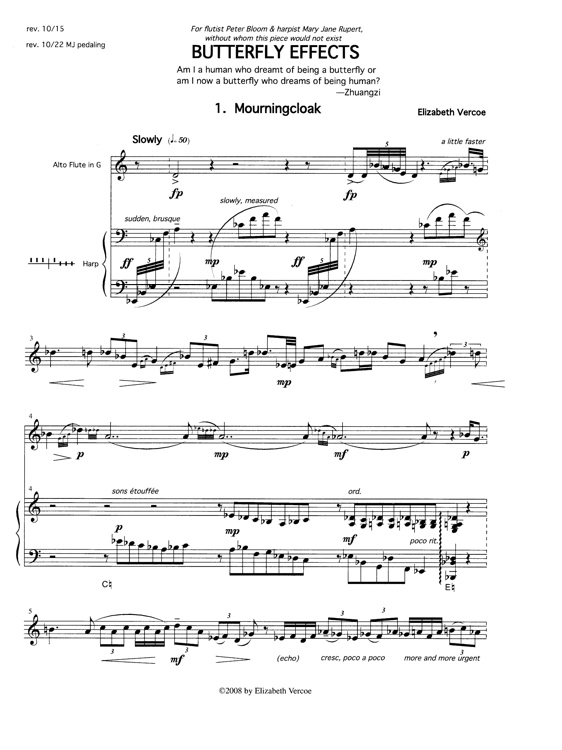Butterfly Effects
for flute & harp (2008-9) (22′)
for oboe & harp (2010) (13′)
Noteworthy Sheet Music (flute version)
Navona Recordings (flute version
Certosa Verlag (oboe version)
MSR Classics CD (oboe version)
Watch a performance of “Banded Blue Pierrot“
“stunningly beautiful” (Cinemusical)
“…an artful exploration of the instruments and a wonderful addition
to the modern chamber musician’s library.” (Flutist Quarterly)
“…a delicate fantasia…her gorgeous music is explored with striking inventiveness.” (ConcertoNet)
Butterfly Effects is in seven sections, originally for flute and harp, in which the flutist is asked to play bass, alto, piccolo and concert flutes. The titles are the names of butterflies: Mourningcloak, Banded Blue Pierrot, Common Jezebel, Question Mark, Monkey Puzzle, Karner Blues, and Psyche. Five movements have been arranged by the composer for oboist Cynthia Green Libby who has recorded the piece with harpist Jeremy Chesman. Noteworthy Sheet Music has published the original flute and harp score online in the U.S and the recording with oboist Peter H. Bloom and Mary Jane Rupert (for whom the piece was written) is slated for release on Navona Recordings in 2018. The oboe version of the score is published by Certosa Verlag in Germany.
The composer writes: Butterfly Effects for flute and harp was written for “2,” with flutist Peter H. Bloom and harpist Mary Jane Rupert who premiered the first parts of the piece in Bangkok in 2009 and the entire work in Illinois in 2010. Along with the butterflies themselves, a quotation from Zhuangzi was the starting point for the music: “Am I a human who dreamt of being a butterfly or am I now a butterfly who dreams of being human?” The Taoist philosopher’s dream illustrates, among other lessons, a sense of oneness with all living beings.
Like other creatures, butterflies are adapted to their environment in interesting and sometimes astonishing ways. The monkey puzzle, for example, has tail filaments that mimic its antennae, apparently to confuse predators, while the toxic common jezebel warns off predators with bright coloration only on the underside of its wings since it spends much time in the forest canopy. An endangered species, the tiny Karner blues were so-named by Vladimir Nabokov, an avid lepidopterist as well as a novelist. Curiously, the Karner blue larva feeds only on wild lupine, the disappearance of which is a reason for its growing rarity. So fragile that their wings may be damaged by a heavy rainstorm, butterflies confound the odds, surviving under difficult conditions, even—like the mourningcloak—wintering over as adults in icy New England.
All seven movements are short, some only a minute in length. Mourningcloak, for alto flute and harp, is somber and reflective. Banded Blue Pierrot (concert flute) is short and glittering. Common Jezebel is a sultry tango for alto flute and harp that becomes increasingly chromatic and contrapuntal, requiring some fancy footwork on the harp. Question Mark (bass flute) requires the flutist to use “beat boxing” and key slap techniques that maximize the percussive qualities of the flute. Monkey Puzzle (alto flute), in a kind of mimicry of the confusing antennae and pseudo antennae of the insect, flutters along to the middle of the piece and then proceeds backwards to the beginning in what is known as retrograde motion. Karner Blues adopts some of the riffs of blues instrumentalists and singers in the only movement for piccolo. Psyche, a word meaning breath or soul in Greek, is for concert flute and reminds us again of the Zhuangzi dream and the oneness of all living beings.

